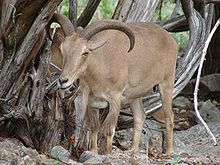Barbary sheep
| Barbary sheep | |
|---|---|

| |
| Scientific classification | |
| Domain: | Eukaryota |
| Kingdom: | Animalia |
| Phylum: | Chordata |
| Class: | Mammalia |
| Order: | Artiodactyla |
| Family: | Bovidae |
| Subfamily: | Caprinae |
| Tribe: | Caprini
|
| Genus: | Ammotragus (Blyth, 1840) |
| Species: | A. lervia
|
| Binomial name | |
| Ammotragus lervia (Pallas, 1777)
| |
| Subspecies | |
|
A. l. angusi Rothschild, 1921 | |
| Synonyms | |
The Barbary sheep (Ammotragus lervia), also known as aoudad (pronounced [ˈɑʊdæd]), is a
Description
Barbary sheep stand 75 to 110 cm (2 ft 6 in to 3 ft 7 in) tall at the shoulder, with a length around 1.5 m (5 ft), and weigh 30 to 145 kg (66 to 320 lb).[5] They are sandy-brown, darkening with age, with a slightly lighter underbelly and a darker line along the back. Upper parts and the outer parts of the legs are a uniform reddish- or grayish-brown. Some shaggy hair is on the throat (extending down to the chest in males) with a sparse mane. Their horns have a triangular cross-section. The horns curve outward, backward, then inward, and can exceed 76 cm (30 in) in length. The horns are fairly smooth, with slight wrinkles evident at the base as the animal matures.[6]
Range
Natural range
Barbary sheep are
Populations within its native range have been decreasing due to hunting, legal and otherwise, and destruction of habitat.[8][9]
Introduced populations

Barbary sheep have been introduced to southeastern Spain[10] and the southwestern United States.[11]
They have become common in a limited region of southeastern Spain, since its introduction in 1970 to
Although the species has not yet been recorded in Australia, it is considered a pest species in Queensland with the potential to establish in the wild.[15]
Taxonomy

A. lervia is the only species in the genus Ammotragus. However, some authors include this genus in the goat genus Capra, together with the sheep genus Ovis.[4]
The subspecies are found allopatrically in various parts of North Africa:[7]
- A. l. lervia Pallas, 1777 (vulnerable)
- A. l. ornata I. Geoffroy Saint-Hilaire, 1827 (Egyptian Barbary sheep, thought to be extinct in the wild but still found in the eastern desert of Egypt)[16][17]
- A. l. sahariensis Rothschild, 1913 (vulnerable)
- A. l. blainei Rothschild, 1913 (vulnerable)
- A. l. angusi Rothschild, 1921 (vulnerable)
- A. l. fassini Lepri, 1930 (vulnerable)
Habitats

Barbary sheep are found in
Names
The
Lervia derives from the wild sheep of northern Africa described as "lerwee" by Rev. T. Shaw in his "Travels and Observations" about parts of
The Spanish named this sheep the arruis, from Berber arrwis, and the Spanish Legion even used it as a mascot for a time.
Aoudad ([ˈɑː.uːdæd]) is the name for this sheep used by the
Gallery
-
Barbary sheep seeks handouts at a Texas wildlife park
-
Ewe and lamb rest in the shade of a tree
-
Lamb (closeup)
-
Barbary sheep at the Wildlife Ranch in San Antonio
-
Barbary sheep at Tierpark Hagenbeck, Hamburg, Germany
-
Ewes and a juvenile atZoologischer Garten, Berlin, Germany
-
Barbary sheep at Tennōji Zoo, Japan
-
Head of a ram
-
Skeleton of a Barbary sheep (Museum of Osteology)
-
Captive Barbary sheep Safari West Santa Rosa, California
References
- . Retrieved 19 November 2021.
- ^ "Appendices | CITES". cites.org. Retrieved 2022-01-14.
- OCLC 62265494.
- ^ OCLC 62265494.
- ^ Ammotragus lervia ultimateungulate.com Archived 2005-10-24 at the Wayback Machine
- ISBN 9781429811255.
- ^ OCLC 62265494.
- .
- ^ Šprem, Nikica; Gančević, Pavao; Safner, Toni; Jerina, Klemen; Cassinello, Jorge (2022). "Barbary Sheep Ammotragus lervia (Pallas, 1777)". Terrestrial Cetartiodactyla. Cham, Switzerland: Springer Verlag. pp. 367–381.
- S2CID 83656269.
- .
- S2CID 24178790.
- .
- ISBN 978-3-319-65038-8.
- ^ "Barbary sheep". July 2016.
- ^ Jamel Ben Mimoun, Jorge Cassinello, Saïd Nouira (January 2016). "Update of the distribution and status of the aoudad Ammotragus lervia (Bovidae, Caprini) in Tunisia". Mammalia.
{{cite journal}}: CS1 maint: multiple names: authors list (link)
Further reading
- Cassinello, J. (1998). Ammotragus lervia: a review on systematics, biology, ecology and distribution. Annales Zoologici Fennici 35: 149-162
- Cassinello, J. (2013). Ammotragus lervia: 595–599. In: Mammals of Africa. Vol VI. Pigs, Hippopotamuses, Chevrotain, Giraffes, Deer and Bovids. JS Kingdon & M Hoffmann (Eds.) Bloomsbury Publishing, London.
- Cassinello, J. (2015). Ammotragus lervia (aoudad). In: Invasive Species Compendium. http://www.cabi.org/isc/datasheet/94507[permanent dead link] CAB International, Wallingford, UK.
- Wacher, T., Baha El Din, S., Mikhail, G. & Baha El Din, M. (2002). New observations of the "extinct" Aoudad Ammotragus lervia ornata in Egypt. Oryx 36: 301–304.











